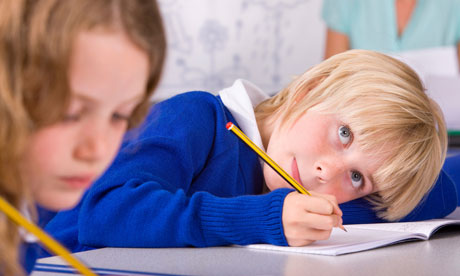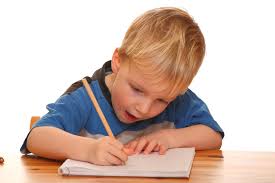My normally chipper, charming, make-you-smile-no-matter-how-yucky-your-day-has-been, second grader comes into my home office looking down. He’s unusually clingy to mom. I ask if he’s ok, and he looks wistfully at mom and whispers that his stomach hurts. She offers to go pick up a snack for him, and he nods slowly. He looks at me with puppy-dog-sad eyes as I try to get him interested in our standard warm-up: reading non-sense words. After a few seconds of listless responses, I push away the blending board and say, “Hey, do you want to dictate a story? We haven’t done one of those in a while.”
His eyes sparkle and he says, “Yeah!” and we get ready for the dictation.
Not surprisingly, his story revolves around food and hunger. Only after the friendly dragon helps with a bar-b-que by blowing fire on it, so that he gets to eat all the food he wants til he is finally full, do our heroes finally get home and live happily ever after.
Mom and I smile knowingly when I tell her about the story (she made it back in record time with a breakfast bar and juice box).
No, this blog is not a plea for free lunches, or a review of Maslow’s Hierarchy of Needs. It’s actually about how writing, or in this case, dictating a story, can be therapeutic for a child.
We all realize our kids come to us with their own social and emotional needs, and sometimes those needs are the immediate, top priority for our student. As a caring and attentive teacher, it is hard to sweep those needs under the rug (yes dear, I know your dog just died. Now, how do you pronounce this word?). It can also be terribly counter-productive to even try. On the other hand, you still gotta get in a solid lesson during the session. Wouldn’t it be great if there were a way to do both?
Enter storytelling. Your student’s need may be as easy to meet as being hungry for breakfast, or it may be as complex as being homesick or wanting to be popular. But in all cases, storytelling can be a way for a child to express–and process–what they are reluctant to say out loud.
About six months ago, this same chipper, charming little boy came to me looking down. I asked him what was wrong, and he sighed, “I don’t know. I just feel sad.” I suggested that it might be a good day to dictate a story, and he shrugged yes.
He dictated: “There was an old dog. That dog was happy, but one day the dog was sad. He wanted to go home because he missed his family.” Now, as an adult who has read Freud, I could pretty quickly see that this was a story about my student, although for him, he was writing about an old dog, period. It didn’t really matter, though, because he was still expressing his needs and feelings, and that is always healthy.
When he paused and said he wasn’t sure what else to write, I said, “Well, most stories have a problem and a solution. You have the problem. Can you think of a solution?”
He dictated, “And he said he was going home to his friends. And they let him. And he was happy again.” The end.
Did this mean I sent him home ASAP? No. We finished the session. But one of the great things about dictating this story was that afterwards, after I said how nice it was that the dog got to go home and be happy, my little kiddo perked up and was able to focus on our work the rest of the fifty minutes.
As teachers, tutors and educational therapists, sometimes it is hard to negotiate the either/or question: pay attention to a student’s emotional needs, or to their academic ones. When we choose one, we often feel guilty about ignoring the other. Storytelling attends to both. My kiddo was able to process and express his feelings in a safe, respectful, solution oriented way and we learned a bit about story structure; he read his story a few times out loud; and he had the homework of reading his story to everyone he knew. It was a win-win, and all the little dogs and dragons got to live happily ever after.
copyright Diana Kennedy 2014





[…] Posts Nail polish and baseball bats; Googling for content with your student The Power of Story Dissolving Writer’s Block In Defense of Pandering Developing details in writing: beyond […]
[…] Enjoy the topic? Check out The Power of Story […]
.. v should express our feelings by any means to keep positive & healthy mind.so its a good idea
I love your sense of humor, warmth, and empathy! And such a wonderful idea! Research has been pretty clear about the emotional value of storytelling and, specifically, how the stories we tell ourselves about ourselves (even if we is an old dog) contribute to our mental health and stability. Kudos!
Excellent idea…I have also allowed them to dictate using a taping device… you can even create a sensory room that resembles a sound studio….what matters is finding a avenue that the child feels comfortable with to express his/her feelings.
As a former teacher, this is a great initiative and something that is lacking in current classrooms; time, empathy and a different way of attending to students!